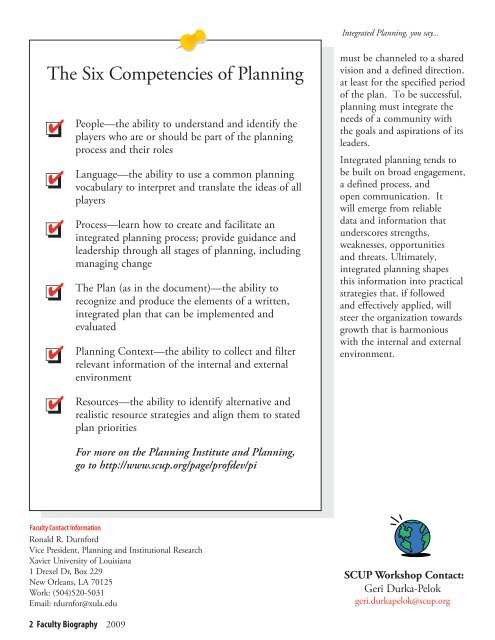Bio - Society for College and University Planning
Bio - Society for College and University Planning
Bio - Society for College and University Planning
You also want an ePaper? Increase the reach of your titles
YUMPU automatically turns print PDFs into web optimized ePapers that Google loves.
Integrated <strong>Planning</strong>, you say...<br />
The Six Competencies of <strong>Planning</strong><br />
People—the ability to underst<strong>and</strong> <strong>and</strong> identify the<br />
players who are or should be part of the planning<br />
process <strong>and</strong> their roles<br />
Language—the ability to use a common planning<br />
vocabulary to interpret <strong>and</strong> translate the ideas of all<br />
players<br />
Process—learn how to create <strong>and</strong> facilitate an<br />
integrated planning process; provide guidance <strong>and</strong><br />
leadership through all stages of planning, including<br />
managing change<br />
The Plan (as in the document)—the ability to<br />
recognize <strong>and</strong> produce the elements of a written,<br />
integrated plan that can be implemented <strong>and</strong><br />
evaluated<br />
<strong>Planning</strong> Context—the ability to collect <strong>and</strong> filter<br />
relevant in<strong>for</strong>mation of the internal <strong>and</strong> external<br />
environment<br />
must be channeled to a shared<br />
vision <strong>and</strong> a defined direction,<br />
at least <strong>for</strong> the specified period<br />
of the plan. To be successful,<br />
planning must integrate the<br />
needs of a community with<br />
the goals <strong>and</strong> aspirations of its<br />
leaders.<br />
Integrated planning tends to<br />
be built on broad engagement,<br />
a defined process, <strong>and</strong><br />
open communication. It<br />
will emerge from reliable<br />
data <strong>and</strong> in<strong>for</strong>mation that<br />
underscores strengths,<br />
weaknesses, opportunities<br />
<strong>and</strong> threats. Ultimately,<br />
integrated planning shapes<br />
this in<strong>for</strong>mation into practical<br />
strategies that, if followed<br />
<strong>and</strong> effectively applied, will<br />
steer the organization towards<br />
growth that is harmonious<br />
with the internal <strong>and</strong> external<br />
environment.<br />
Resources—the ability to identify alternative <strong>and</strong><br />
realistic resource strategies <strong>and</strong> align them to stated<br />
plan priorities<br />
For more on the <strong>Planning</strong> Institute <strong>and</strong> <strong>Planning</strong>,<br />
go to http://www.scup.org/page/profdev/pi<br />
Faculty Contact In<strong>for</strong>mation<br />
Ronald R. Durn<strong>for</strong>d<br />
Vice President, <strong>Planning</strong> <strong>and</strong> Institutional Research<br />
Xavier <strong>University</strong> of Louisiana<br />
1 Drexel Dr, Box 229<br />
New Orleans, LA 70125<br />
Work: (504)520-5031<br />
Email: rdurn<strong>for</strong>@xula.edu<br />
SCUP Workshop Contact:<br />
Geri Durka-Pelok<br />
geri.durkapelok@scup.org<br />
Faculty <strong>Bio</strong>graphy 2009
















